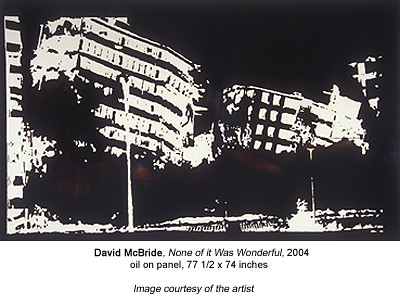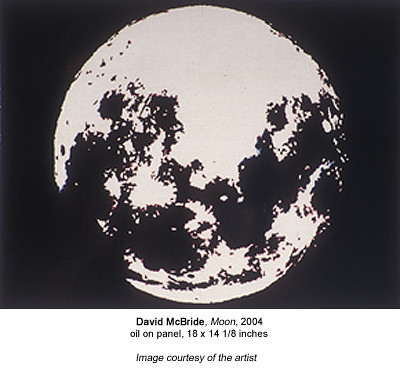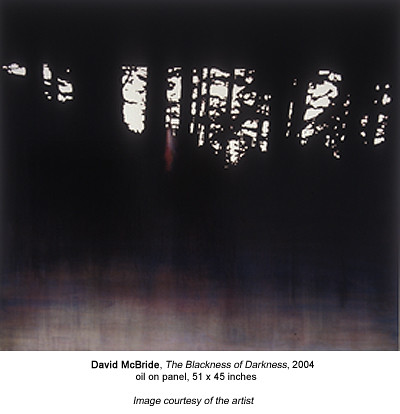
My interest is in subject matter that can be associated with modern myths. By creating paintings dealing with the exploration of space and modern architecture, for example, I am attempting to identify two instances of social ideals that attain the status of myth.Formally, the work is an attempt to blur the distinction between the mediums of painting and photography.* This blurring proposes to refute a formalist approach to aesthetics, by utilizing elements of different mediums within the same work. By using representations of painting and photography that employ signifying elements of each, the work proposes that these media are themselves myths of the avant-garde. – David McBride
Titled None of It Was Wonderful, the painting above depicts a bitter sweet relationship with modernism. The crumbling of mid 20th century buildings can be seen as the fall of modernist ideals, though the title suggests some dissatisfaction with the new as well as the old. Where we left and where we begin is indistinguishable but for the looming notion of “the new” that is fixed on the horizon.
David McBride discusses his painting philosophy in his studio, telling me that part of working with these ideas is to understand that we are in some ways moving away from modernist and post-modernist thought. Clearly, this is true, but even the use twentieth century iconography does not negate or recontextualize the twenty first century aesthetics that reflect these changes.

And as McBride well knows, the philosophical and personal underpinnings of paintings need not exist entirely on the surface. They may inform the work, but they rarely represent its full meaning. In fact, it is often more interesting when the viewer is confronted with traces of these larger ideas, leaving the narrative to be revealed by the image itself. The trouble with this of course, is that inevitably artists encounter lazy viewers, who insist on trumpeting formalism to such a point that it eclipses the deeper meaning of the work.
Obviously, McBride is no photorealist, but as a representational painter who works from the photograph, what separates this artists from so many, is his ability to choose interesting subject matter. The seventies brought us some truly excellent photorealist painting, and scholarship on the like (namely Rosalind Krauss who applies Charles Pierce’s ideas of the indexical, the icon, and the symbolic** to realism) but it also inspired a lot of meaningless painting, that assumed that art theory and technique would be enough to support the work. McBride alludes to the theory that inspired a lot of this kind of work in his statement, and it would seem to me that he does so because what he depicts is so often the trace of these larger ideas.
It is difficult to get a feel for how these paintings function without having seen them in person, and what is not apparent through a jpeg, is the fact that each work has a varnish applied to it leaving the surface glossy and dark. Despite being essentially silhouettes, there is not the flatness to them that is commonly associated with this technique. The balance in these paintings lies in the artist’s ability to suggest space without resorting to overt rendering of the subject, or conversely an over simplified silhouette of a photograph.

Aptly titled, The Blackness of Darkness, McBride’s text specifically speaks to the photographic process, which literally is as he describes it, but is also the mechanical documentation of an uncertain future. Is it meaningful that these paintings become stencils before being transferred to the photograph? Possibly, but in the case of McBride, it seems to me the importance lies less in the process, than in the subject matter itself. Paintings that are at blithely hopeful yet desperately cynical of the man’s future prospects should be a mess of confusion and contradiction. And still, they are not.
*This reference is to critical avant-garde theory as espoused in the modernist writings of Clement Greenberg and the postmodernism of those writers associated with the MIT Press during the 1970s and 80s: Douglas Crimp, Hal Foster, Rosalind Krauss are a few.
** For those who aren’t familiar with these terms, as Pierce defines it, all signs are partly iconic, which means they denote resemblance to their objects, indexical, meaning they are actually affected by their objects (for example a sundial), and symbolic meaning an arbitrary learned designation.


Comments on this entry are closed.